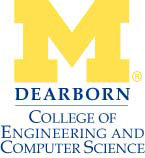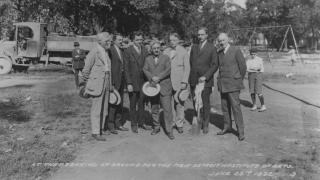
 A staggering 98,000 fatalities occur in U.S. hospitals each year that are attributed to medical errors.
A staggering 98,000 fatalities occur in U.S. hospitals each year that are attributed to medical errors.
A team of UM-Dearborn engineering students would like to see that number reduced and has designed a “telemetracking” system that could potentially ease the burden on health care staff.
“Telemetracking is the idea of biotelemetry meets tracking,” explained team member Michael Ehlert. “In other words, the ability to remotely measure and report biological data, combined with the added feature of asset and personnel tracking. In a way, Telemetracking creates a ‘smart’ hospital.”
The team—consisting of Ehlert and fellow students Daniel Cwiertak, Matthew Nitz* and Khun Sok--built the system as part of the College of Engineering and Computer Science’s annual senior design competition.
The students, who won the contest in the electrical and computer engineering department category, worked under the direction of Weidong Xiang, associate professor of electrical and computer engineering at UM-Dearborn.
The team’s design is comprised of a custom-built electrocardiogram (EKG) device, radiofrequency identification (RFID) module, low-power wireless transmitters and receivers, brought together by a graphical user interface (GUI).
“This all sounds complicated, but the idea behind it is simple: provide an inexpensive means to monitor a person’s electrocardiograph, or heart signal, wirelessly and on the move,” Ehlert said. “Furthermore, be able to determine a patient’s last known location relatively quickly. Both of these functions can be accomplished from a central interface that is easy to view from any PC or, in the future, a tablet computer.”
In other words, if a cardiology patient was admitted for observation and collapsed in a hallway, the proper medical personnel could be alerted and be able to respond quickly, Ehlert noted.
Future applications for this technology could include error checking during medical stays. For instance, verifying that the blood type for a transfusion is compatible with a specific patient. Telemetracking could also be expanded to track hospital inventory and cut costs.
The project posed many challenges for the students as they learned more about the technologies they were working with.
“Since wireless communications interested me, but I did not know much in the area, specifically in the IEEE 802.15.4 standard that I used, the challenge of learning, understanding and applying that information was tough but one that I managed to overcome with some time,” said Cwiertak.
“The most challenging aspect of the project, for me, was organizing the ideas taken from our research and applying them to create a working project,” said Sok. “Designing a safe, and reliable system was also challenging. I focused on acquiring an EKG signal, which produced its own set of difficulties. It was challenging to find solutions to problems I had never come across before.”
The students say they learned a lot from the project, including enhancing their skills, acquiring new ones and the true meaning of teamwork.
“The project would have never been achieved without the full commitment from all members of the team,” Sok said. “We tried to help and encourage each other to achieve the team goal. This was a very important lesson: never leave anyone in the team behind to accomplish the goal.”
*EDITOR’S NOTE: CECS is sad to report that Matthew Nitz passed away shortly after completing the senior design project. The CECS executive committee approved Matt receiving his engineering degree posthumously.




